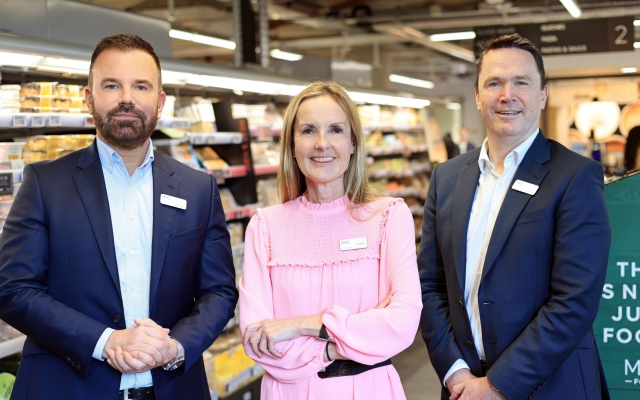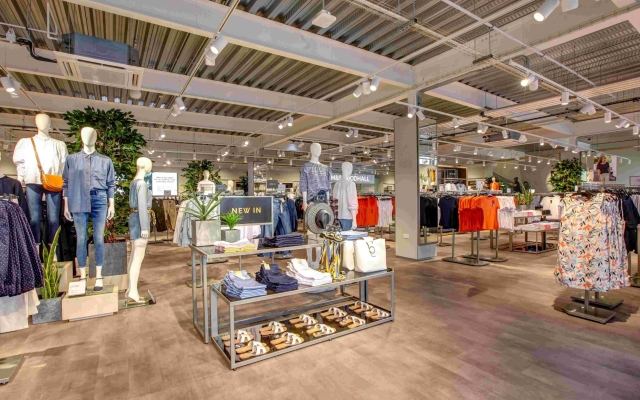 M&S co-CEO Cathy Bickerstaff (center) announced that the retailer will be selling competing brands for the first time last year. : Oliver Dixon
M&S co-CEO Cathy Bickerstaff (center) announced that the retailer will be selling competing brands for the first time last year. : Oliver Dixon
As the employee-owned department store struggles with losses, unrest among partners and worries about its strategy, Marks & Spencer saw an opportunity to steal his crown as a mid-range outfitter.
M&S is actively reaching out to brands represented by John Lewis to get them to list their products.
“They have seen us working with John Lewis and they are doing well,” says the CEO. one brand.
M&S now lists nearly 200 third-party home, fashion, footwear and beauty brands on its website. John Lewis also offers over 120 items.
In many cases, M&S has found a receptive audience. The recent negative reviews of John Lewis «never do any good and our clients actually read a lot of what's out there,» the executive said.
«We need to make sure there's value on both sides, and if if it's not there, we'll be investing more in the other websites we're registered with.”
Some clothing companies are said to be unhappy with the chunk of sales that John Lewis got. The department store has been reported to be charging commissions and fees of up to 50% in 2021 and is reportedly seeking to increase this rate.
Around the same time, fashion brand Seasalt retired its lines from John Lewis, citing «strategic reasons». The Cornish brand is now featured on M&S and announced a deal extension last week.
 Marks & Spencer brought in outside clothing brands and modernized its stores. Photo: Marks & Spencer
Marks & Spencer brought in outside clothing brands and modernized its stores. Photo: Marks & Spencer
Brands listed on both M&S and John Lewis said the former offered better commissions for retailers.
A spokesperson for John Lewis said their commission rates were «fair» and said that the company «continues to attract prestige brands and has attracted 65 new fashion, beauty and children's brands this year.»
One brand executive says of M&S: «We find them easy to work with and they are central to our strategy for the next five years.”
Many observers wonder if the company can finally spin its long-suffering clothing business.
While M&S has a strong base of loyal female customers who buy lingerie and other essentials, in for years, the company has struggled to shake off the image of gaudiness that has developed over the past decades.
As a result, inefficient clothing and the home division are constantly dragging down overall productivity.
Having competing brands that can appeal to different age groups and demographics could be the key to making a difference.
In the past 12 months, it has grown from 40 to 60 clothing and footwear brands, including Clarks, Jaeger, Ted Baker and White Stuff. Executives hope to increase that number to 100 in the coming years.
M&S has poached Amazon CEO Nishi Mahajan, who ran the online giant's fashion business in February, to take over.
The fruits of Bickerstaff and her colleagues' labors will be revealed this week when M&S reports full-year results on Wednesday.
M&S or John Lewis POLL
City expects apparel and housing sales to increase 10.5% this year until early April, after a sharp rise at Christmas.
More than £1 for every £10 spent on clothing around Christmas went to Marks & Spencer marks the retailer's best performance in eight years, according to Kantar.
“If they are announcing two consecutive periods of growth in sales, then even a cynic like me would start talking, maybe there is a change here. «, says Richard Hyman, an analyst at Thought Provoking Consulting.
Clive Black, an analyst at Shore Capital, said M&S currently looks «blurred side up» as data suggests that the retailer » gaining a healthy share in clothing, household and food simultaneously and consistently, a rare occurrence in the last two decades.»
For many years, M&S has placed its future in food. Grocery still plays a key role for the group, but the focus on clothing was accidental: margins and supermarket sales are under heavy pressure due to soaring inflation and the cost of living crisis.
As a result, it is expected that sales growth in its food division will be slightly weaker at 7.7%.
M&S's strong performance is due in no small part to the weakness of rival John Lewis. The department store, which also owns Waitrose, recently canceled employee bonuses and warned of job cuts after a steep £234m loss last year.
Competitors expect M&S to outperform John Lewis. A partnership as the UK's seventh largest retailer is possible as early as this year.
«M&S is clearly getting a cut from the increasingly troubled partnership with John Lewis,» Credit Suisse analysts say.
According to YouGov's annual rankings, M&S is currently considered the UK's strongest brand, up from number three in 2019. At the same time, John Lewis dropped from first to sixth.
Nevertheless. , these are the first days. Hyman said there are some concerns that third-party brand inventory will not cannibalize M&S sales rather than increase the pie.
Some inside the company are already grumbling that outside brands are selling better than some homegrown ones. M& ;S-lines.
Managers encourage employees to use this as an opportunity to be more creative. Bickerstaff said in October that the shift was «countercultural and it's a credit to the team that we pulled it off.»
This week's results will give a clear indication of whether the strategy is driving higher sales or just spurring buyers buy third-party products at lower margins.
After years of stagnation, M&S may finally be back in vogue.























































Свежие комментарии